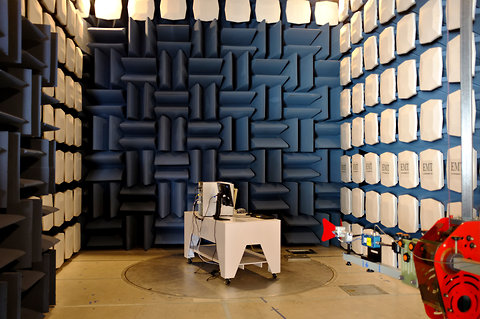 Nick Bilton/The New York TimesEMT Labs, a testing center in Mountain View, Calif., measures electromagnetic interference from gadgets to ensure that they meet Federal Communications Commission standards.
Nick Bilton/The New York TimesEMT Labs, a testing center in Mountain View, Calif., measures electromagnetic interference from gadgets to ensure that they meet Federal Communications Commission standards.
The Federal Aviation Administration has its reasons for preventing passengers from reading from their Kindles and iPads during takeoff and landing. But they just don’t add up.
Since I wrote a column last month asking why these rules exist, I’ve spoken with the F.A.A., American Airlines, Boeing and several others trying to find answers. Each has given me a radically different rationale that contradicts the others. The F.A.A. admits that its reasons have nothing to do with the undivided attention of passengers or the fear of Kindles flying out of passengers’ hands in case there is turbulence. That leaves us with the danger of electrical emissions.
For answers, I headed down to EMT Labs, an independent testing facility in Mountain View, Calif., that screens electrical emissions of gadgets that need to pass health, safety and interference standards.
Before I share the results of the tests EMT ran, let me explain what this means. Every electronic device throws off electrical emissions. This is the slight hum of energy that emanates from a device when in use. Labs like EMT test electronics of all sizes to ensure that they meet government standards and will not interfere with other electronics when in use.
Gadgets are tested by monitoring the number of volts per meter coming off a device. The F.A.A. requires that before a plane can be approved as safe, it must be able to withstand up to 100 volts per meter of electrical interference.
When EMT Labs put an Amazon Kindle through a number of tests, the company consistently found that this e-reader emitted less than 30 microvolts per meter when in use. That’s only 0.00003 of a volt.
“The power coming off a Kindle is completely minuscule and can’t do anything to interfere with a plane,” said Jay Gandhi, chief executive of EMT Labs, after going over the results of the test. “It’s so low that it just isn’t sending out any real interference.”
But one Kindle isn’t sending out a lot of electrical emissions. But surely a plane’s cabin with dozens or even hundreds will? That’s what both the F.A.A. and American Airlines asserted when I asked why pilots in the cockpit could use iPads, but the people back in coach could not. Yet that’s not right either.
“Electromagnetic energy doesn’t add up like that. Five Kindles will not put off five times the energy that one Kindle would,” explained Kevin Bothmann, EMT Labs testing manager. “If it added up like that, people wouldn’t be able to go into offices, where there are dozens of computers, without wearing protective gear.”
Bill Ruck, principal engineer at CSI Telecommunications, a firm that does radio communications engineering, added: “Saying that 100 devices is 100 times worse is factually incorrect. Noise from these devices increases less and less as you add more.”
The F.A.A. does allow some electronics during takeoff and landing. Portable voice recorders, hearing aids, heart pacemakers and electric shavers are permitted during all times of a flight.
So I took a Sony voice recorder that I bought at Best Buy and tested that too. The results? The voice recorder puts off almost exactly the same electrical emissions as the Kindle. In many instances of the test, the voice recorder actually emitted more.
In 2006, a report commissioned by the F.A.A. determined that people could not use electronics during takeoff and landing. I asked Dave Carson, a Boeing engineer who was co-chairman of the group that wrote the report, why we are allowed voice recorders and electric razors but not Kindles and iPads.
In an e-mail, Mr. Carson said that voice recorders and razors had been determined to “not cause interference with the navigation or communication system of the aircraft on which it is to be used” though he wrongly thought that the F.A.A. banned those devices nonetheless. Mr. Ruck said: “The only reason these rules exist from the F.A.A. is because of agency inertia and paranoia.”
The F.A.A. and other groups seem to be running out of reasons we can’t use digital e-readers on planes during takeoff and landing. Maybe their next response will be: “Because I said so!”
Article source: http://feeds.nytimes.com/click.phdo?i=f7c2754f3ed410ac3d33676fbe8fd230